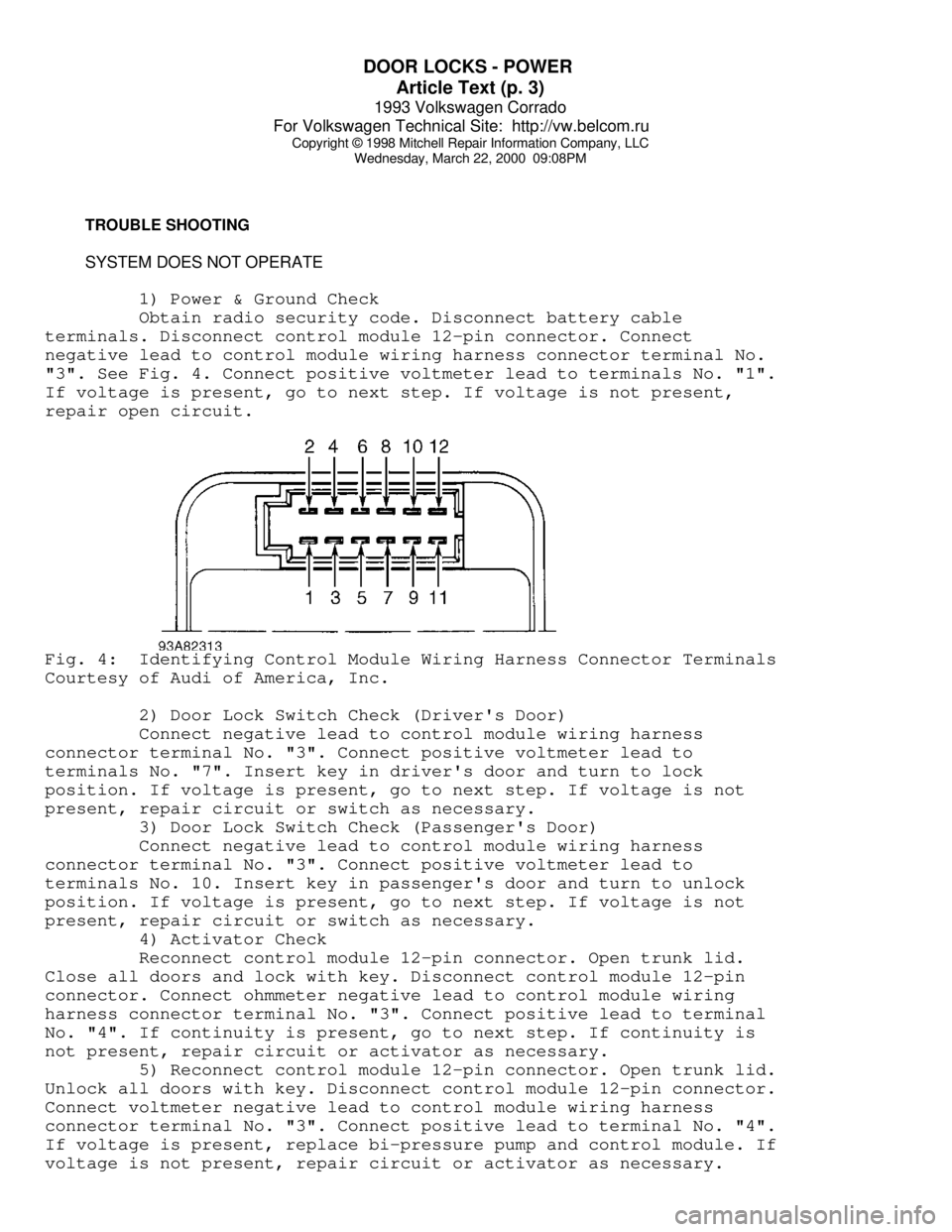1993 VOLKSWAGEN CORRADO key battery
[x] Cancel search: key batteryPage 423 of 920

ANTI-THEFT SYSTEM
Article Text
1993 Volkswagen Corrado
For Volkswagen Technical Site: http://vw.belcom.ru
Copyright © 1998 Mitchell Repair Information Company, LLC
Wednesday, March 22, 2000 08:57PM
ARTICLE BEGINNING
1993 ACCESSORIES & EQUIPMENT
Volkswagen Anti-Theft
Volkswagen; Corrado SLC, Passat
DESCRIPTION & OPERATION
The anti-theft system monitors the radio, all doors, hood and
trunk lid position. When the anti-theft system is activated, The horn
and emergency flashers will be activated and the vehicle will not
start. The windows and sun roof (if equipped) are not monitored.
The anti-theft system has self-diagnostic capabilities that
monitor all components and wiring harness. If the system is
functioning correctly, the horn will sound briefly after front door is
locked with the key.
ANTI-THEFT CONTROL MODULE LOCATION TABLEÄÄÄÄÄÄÄÄÄÄÄÄÄÄÄÄÄÄÄÄÄÄÄÄÄÄÄÄÄÄÄÄÄÄÄÄÄÄÄÄÄÄÄÄÄÄÄÄÄÄÄÄÄÄÄÄÄÄÄÄModel Location
Corrado SLC ...................... Behind Right Kick Panel
Passat ...................... Driver Side Fuse/Relay Panel
ÄÄÄÄÄÄÄÄÄÄÄÄÄÄÄÄÄÄÄÄÄÄÄÄÄÄÄÄÄÄÄÄÄÄÄÄÄÄÄÄÄÄÄÄÄÄÄÄÄÄÄÄÄÄÄÄÄÄÄÄ TROUBLE SHOOTING
SYSTEM DOES NOT OPERATE
NOTE: Ensure battery is fully charged and all fuses are okay.
1) Ground Circuit Check
Obtain radio security code. Disconnect battery cable
terminals. Disconnect anti-theft control module 6-pin and 10-pin
wiring harness connector. See ANTI-THEFT CONTROL MODULE LOCATION
table. Connect ohmmeter negative lead to ground. Connect positive lead
to anti-theft control module 10-pin wiring harness connector terminal
No. "3" (Brown wire). If continuity is present, go to next step. If
continuity is not present, repair open circuit.
2) Power Circuit Check
Connect battery cable terminals. Connect voltmeter negative
lead to ground. Connect positive lead to anti-theft control module 6-
pin wiring harness connector terminal No. "3" (Red wire). Switch
positive lead to anti-theft control module 10-pin wiring harness
connector terminal No. "1" (Red wire). If 12 volts are present at both
terminals, go to next step. If 12 volts are not present, repair open
circuit.
3) Turn ignition on. Leave voltmeter negative lead connected
to ground. Connect positive lead to anti-theft control module 10-pin
wiring harness connector terminal No. "4" (Black wire for Corrado;
Page 424 of 920

ANTI-THEFT SYSTEM
Article Text (p. 2)
1993 Volkswagen Corrado
For Volkswagen Technical Site: http://vw.belcom.ru
Copyright © 1998 Mitchell Repair Information Company, LLC
Wednesday, March 22, 2000 08:57PM
Black/Yellow wire for Passat). If 12 volts are present, go to next
step. If 12 volts are not present, repair open circuit.
4) Alarm Horn Check
Turn ignition off. Connect ohmmeter negative lead to ground.
Connect positive lead to anti-theft control module 6-pin wiring
harness connector terminal No. "4" (Black/Yellow wire). If continuity
is present, go to next step. If continuity is not present, repair open
circuit. If circuit is okay, replace alarm horn.
5) Door Lock Switch Check
Connect voltmeter negative lead to ground. Connect positive
lead to anti-theft control module 10-pin wiring harness connector
terminal No. "7" (Red/Yellow wire for Corrado; Yellow/Red for Passat).
Insert key in driver's door lock. Turn key to lock position and hold
momentarily. Voltmeter should register 12 volts. Repeat procedure for
passengers door. If voltage is correct for each door, go to next step.
If voltage is not correct, repair open circuit or replace switch.
6) Door Lock Switch Check
Connect voltmeter negative lead to ground. Connect positive
lead to anti-theft control module 10-pin wiring harness connector
terminal No. "6" (Red/Black wire). Insert key in driver's door lock.
Turn key to unlocked position and hold momentarily. Voltmeter should
register 12 volts. Repeat procedure for passengers door. If voltage is
correct for each door, go to next step. If voltage is not correct,
repair open circuit or replace switch.
7) Alarm Switch & Hood Check
Connect ohmmeter negative lead to ground. Disconnect negative
battery cable. Connect positive lead to the following anti-theft
control module connector terminals:
* 10-pin harness connector terminal No. "5" (Gray wire).
* 10-pin harness connector terminal No. "8" (Brown/Red wire).
* 10-pin harness connector terminal No. "9" (Brown/Green wire).
* 10-pin harness connector terminal No. 10 (Brown/White wire for
Corrado SLC; Brown/Green wire for Passat).
If continuity is present, check for circuit short to ground. If
circuit is okay, replace switch. If continuity is not present, go to
next step.
8) Indicator Light Check
Leave ohmmeter negative lead connected to ground. Connect
negative battery cable. Using multimeter set on 10 A DC scale, connect
positive lead to anti-theft control module 10-pin wiring harness
connector terminal No. "2". If indicator light comes on, replace anti-
theft control module. If indicator light does not come on, repair open
circuit in wiring harness.
ALARM SYSTEM WILL NOT SWITCH OFF
1) Ground Circuit Check
Ensure battery is fully charged. Obtain radio security code.
Disconnect battery cable terminals. Disconnect anti-theft control
module 6-pin and 10-pin wiring harness connector. See ANTI-THEFT
CONTROL MODULE LOCATION table. Reconnect battery cable terminals.
2) Connect voltmeter negative lead to ground. Connect
Page 425 of 920

ANTI-THEFT SYSTEM
Article Text (p. 3)
1993 Volkswagen Corrado
For Volkswagen Technical Site: http://vw.belcom.ru
Copyright © 1998 Mitchell Repair Information Company, LLC
Wednesday, March 22, 2000 08:57PM
positive lead to anti-theft control module 10-pin wiring harness
connector terminal No. "7" (Red/Yellow wire for Corrado SLC;
Yellow/Red wire for Passat). Insert key in driver's door lock. Turn
key against stop and hold momentarily. Voltmeter should register 12
volts. Repeat procedure for passengers door. If voltage is correct for
each door, go to next step. If voltage is correct, repair door switch
or open circuit.
3) Door Lock Switch Check
Connect voltmeter negative lead to ground. Connect positive
lead to anti-theft control module 10-pin wiring harness connector
terminal No. "6" (Red/Black wire). Insert key in driver's door lock.
Turn key against stop and hold momentarily. Voltmeter should register
12 volts. Repeat procedure for passengers door. If voltage is correct
for each door, replace control module. If voltage is not correct,
repair door switch or open circuit.
ALARM HORN INOPERATIVE
1) Alarm Horn Check
Ensure battery is fully charged. Obtain radio security code.
Disconnect battery cable terminals. Disconnect anti-theft control
module 6-pin and 10-pin wiring harness connector. See ANTI-THEFT
CONTROL MODULE LOCATION table.
2) Connect ohmmeter negative lead to ground. Connect positive
lead to anti-theft control module 6-pin wiring harness connector
terminal No. "4" (Black/Yellow wire). If continuity is present,
replace anti-theft control module. If continuity is not present, check
for open circuit and repair as necessary. If circuit is okay, replace
alarm horn.
LIGHTS DO NOT FLASH
1) Alarm Horn Check
Ensure battery is fully charged and emergency flasher system
is functional. Obtain radio security code. Disconnect battery cable
terminals. Disconnect anti-theft control module 6-pin and 10-pin
wiring harness connector. See ANTI-THEFT CONTROL MODULE LOCATION
table.
2) Connect voltmeter negative lead to ground. Connect
positive lead to anti-theft control module 6-pin wiring harness
connector terminal No. "1" (Black/White wire for Corrado SLC; Black
Yellow wire for Passat). Turn emergency flashers on. When lights flash
on, battery voltage should be present.
3) Remove voltmeter positive from terminal No. "1" and
connect to terminal No. "2" (Black/Green wire for Corrado SLC;
Green/Black wire for Passat). Turn emergency flashers on. When lights
flash on, battery voltage should be present. If voltage is correct,
replace anti-theft control module. If voltage is not correct, repair
open circuit in wiring harness between anti-theft control module and
lights.
ENGINE DOES NOT CRANK WITH ALARM SYSTEM OFF
Page 426 of 920

ANTI-THEFT SYSTEM
Article Text (p. 4)
1993 Volkswagen Corrado
For Volkswagen Technical Site: http://vw.belcom.ru
Copyright © 1998 Mitchell Repair Information Company, LLC
Wednesday, March 22, 2000 08:57PM
1) Alarm Horn Check
Ensure battery is fully charged and emergency flasher system
is functional. Obtain radio security code. Disconnect battery cable
terminals. Disconnect anti-theft control module 6-pin and 10-pin
wiring harness connector. See ANTI-THEFT CONTROL MODULE LOCATION
table.
2) Reconnect negative battery cable. Connect voltmeter
negative lead to ground. Connect positive lead to anti-theft control
module 6-pin wiring harness connector terminal No. "5" (Red/Green wire
for Corrado SLC; Red/White wire for Passat). Observe voltmeter while
turning ignition to START position. If battery voltage is present, go
to next step. If battery voltage is not present, repair circuit to
ignition switch.
3) Remove ignition key. Disconnect negative battery cable.
Connect ohmmeter negative lead to ground. Connect positive lead to
anti-theft control module 6-pin wiring harness connector terminal No.
"6" (Red/Black wire for Corrado SLC; Violet/Black wire for Passat). If
continuity is present, replace anti-theft control module. If
continuity is not present, check wiring harness to starter for open
circuit.
WIRING DIAGRAMS
For wiring see WIRING DIAGRAMS article.
END OF ARTICLE
Page 451 of 920

COMPUTER RELEARN PROCEDURES
Article Text
1993 Volkswagen Corrado
For Volkswagen Technical Site: http://vw.belcom.ru
Copyright © 1998 Mitchell Repair Information Company, LLC
Wednesday, March 22, 2000 08:58PM
ARTICLE BEGINNING
GENERAL INFORMATION
Computer Relearn Procedures
All Models
* PLEASE READ THIS FIRST *
The following general procedures are to be used if
driveability problems are encountered after power loss or battery has
been disconnected. These procedures may provide an aid in eliminating
these problems.
To reduce the possibility of complaints, after any service
which requires battery power to be disconnected, vehicle should be
road tested.
COMPUTER RELEARN PROCEDURES
Vehicles equipped with engine or transmission computers may
require a relearn procedure after vehicle battery is disconnected.
Many vehicle computers memorize and store vehicle operation patterns
for optimum driveability and performance. When vehicle battery is
disconnected, this memory is lost. The computer will use default data
until new data from each key start is stored. As computer memorizes
vehicle operation for each new key start, driveability is restored.
Vehicle computers may memorize vehicles operation patterns for 40 of
more key starts.
Customers often complain of driveability problems during
relearn stage because vehicle acts differently then before being
serviced. Depending on type and make of vehicle and how it is
equipped, the following complaints (driveability problems) may exist:
* Harsh Or Poor Shift Quality
* Rough Or Unstable Idle
* Hesitation Or Stumble
* Rich Or Lean Running
* Poor Fuel Mileage
These symptoms and complaints should disappear after a number
of drive cycles have been memorized. To reduce the possibility of
complaints, after any service which requires battery power to be
disconnected, vehicle should be road tested. If a specific relearn
procedure is not available, the following procedure may be used:
Automatic Transmission
* Set parking brake, start engine in "P" or "N" position.
Warm-up vehicle to normal operating temperature or until
cooling fan cycles.
* Allow vehicle to idle for one minute in "N" position. Select
Page 501 of 920

DOOR LOCKS - POWER
Article Text (p. 3)
1993 Volkswagen Corrado
For Volkswagen Technical Site: http://vw.belcom.ru
Copyright © 1998 Mitchell Repair Information Company, LLC
Wednesday, March 22, 2000 09:08PM
TROUBLE SHOOTING
SYSTEM DOES NOT OPERATE
1) Power & Ground Check
Obtain radio security code. Disconnect battery cable
terminals. Disconnect control module 12-pin connector. Connect
negative lead to control module wiring harness connector terminal No.
"3". See Fig. 4. Connect positive voltmeter lead to terminals No. "1".
If voltage is present, go to next step. If voltage is not present,
repair open circuit.Fig. 4: Identifying Control Module Wiring Harness Connector Terminals
Courtesy of Audi of America, Inc.
2) Door Lock Switch Check (Driver's Door)
Connect negative lead to control module wiring harness
connector terminal No. "3". Connect positive voltmeter lead to
terminals No. "7". Insert key in driver's door and turn to lock
position. If voltage is present, go to next step. If voltage is not
present, repair circuit or switch as necessary.
3) Door Lock Switch Check (Passenger's Door)
Connect negative lead to control module wiring harness
connector terminal No. "3". Connect positive voltmeter lead to
terminals No. 10. Insert key in passenger's door and turn to unlock
position. If voltage is present, go to next step. If voltage is not
present, repair circuit or switch as necessary.
4) Activator Check
Reconnect control module 12-pin connector. Open trunk lid.
Close all doors and lock with key. Disconnect control module 12-pin
connector. Connect ohmmeter negative lead to control module wiring
harness connector terminal No. "3". Connect positive lead to terminal
No. "4". If continuity is present, go to next step. If continuity is
not present, repair circuit or activator as necessary.
5) Reconnect control module 12-pin connector. Open trunk lid.
Unlock all doors with key. Disconnect control module 12-pin connector.
Connect voltmeter negative lead to control module wiring harness
connector terminal No. "3". Connect positive lead to terminal No. "4".
If voltage is present, replace bi-pressure pump and control module. If
voltage is not present, repair circuit or activator as necessary.
Page 581 of 920

FUSES & CIRCUIT BREAKERS
Article Text (p. 3)
1993 Volkswagen Corrado
For Volkswagen Technical Site: http://vw.belcom.ru
Copyright © 1998 Mitchell Repair Information Company, LLC
Wednesday, March 22, 2000 09:11PM
start at any time even when the ignition key is in the OFF
position. DO NOT loosen or remove radiator cap when cooling
system is hot.
REPLACING BLOWN FUSES
Before replacing a blown fuse, remove ignition key, turn off
all lights and accessories to avoid damaging the electrical system. Be
sure to use fuse with the correct indicated amperage rating. The use
of an incorrect amperage rating fuse may result in a dangerous
electrical system overload.
BATTERY WARNING
WARNING: When battery is disconnected, vehicles equipped with
computers may lose memory data. When battery power is
restored, driveability problems may exist on some vehicles.
These vehicles may require a relearn procedure. See COMPUTER
RELEARN PROCEDURES article in GENERAL INFORMATION section.
BRAKE PAD WEAR INDICATOR
Indicator will cause a squealing or scraping noise, warning
that brake pads need replacement.
HALOGEN BULBS
Halogen bulbs contain pressurized gas which may explode if
overheated. DO NOT touch glass portion of bulb with bare hands. Eye
protection should be worn when handling or working around halogen
bulbs.
SUPPLEMENTAL RESTRAINT SYSTEM (AIR BAG)
NOTE: See the AIR BAGS article in the ACCESSORIES/SAFETY EQUIPMENT
Section.
Modifications or improper maintenance, including incorrect
removal and installation of the Supplemental Restraint System (SRS),
can adversely affect system performance. DO NOT cover, obstruct or
change the steering wheel horn pad in any way, as such action could
cause improper function of the system. Use only plain water when
cleaning the horn pad. Solvents or cleaners could adversely affect the
air bag cover and cause improper deployment of the system.
WARNING: To avoid injury from accidental air bag deployment, read and
carefully follow all warnings and service precautions. See
appropriate AIR BAGS article in ACCESSORIES/SAFETY EQUIPMENT.
CAUTION: Disconnect negative battery cable before servicing any air
bag system, steering column or passenger side dash
component. After any repair, turn ignition key to the ON
Page 683 of 920

SCHEDULED SERVICES
Article Text
1993 Volkswagen Corrado
For Volkswagen Technical Site: http://vw.belcom.ru
Copyright © 1998 Mitchell Repair Information Company, LLC
Wednesday, March 22, 2000 09:22PM
ARTICLE BEGINNING
1990-94 MAINTENANCE
Volkswagen Maintenance & Service Intervals
Corrado G60 (1990-92)
SLC (1992-94 USA)
VR6 (1992-94 Canada)
* PLEASE READ THIS FIRST *
NOTE: All SERVICE SCHEDULES are listed for normal service
vehicles. If vehicle is operated under severe service
conditions, see SEVERE SERVICE REQUIREMENTS (PERFORM
W/SERVICE SCHEDULES) for items requiring additional
maintenance.
NOTE: This article contains scheduled maintenance service
information. Fluid types and capacities listed with each
service in this article are only those necessary to perform
that scheduled service. For specifications pertaining to
fluid capacities for the entire vehicle, fuse and circuit
breaker identification, wheel and tire size, battery type,
warranty information, or model identification refer to the
MAINTENANCE INFORMATION article in this section.
CAUTIONS & WARNINGS
SUPPLEMENTAL RESTRAINT SYSTEM (AIR BAG) - 1995 MODELS
NOTE: See the AIR BAGS article in the ACCESSORIES/SAFETY EQUIPMENT
Section.
Modifications or improper maintenance, including incorrect
removal and installation of the Supplemental Restraint System (SRS),
can adversely affect system performance. DO NOT cover, obstruct or
change the steering wheel horn pad in any way, as such action could
cause improper function of the system. Use only plain water when
cleaning the horn pad. Solvents or cleaners could adversely affect the
air bag cover and cause improper deployment of the system.
WARNING: To avoid injury from accidental air bag deployment, read and
carefully follow all warnings and service precautions. See
appropriate AIR BAGS article in ACCESSORIES/SAFETY EQUIPMENT.
CAUTION: Disconnect negative battery cable before servicing any air
bag system, steering column or passenger side dash
component. After any repair, turn ignition key to the ON
position from passenger's side of vehicle in case of
accidental air bag inflation